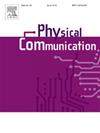Active elements for Hybrid Relay-Reflecting Intelligent Surface-assisted secrecy wireless communications: A Jaya-based optimization approach
IF 2
4区 计算机科学
Q3 ENGINEERING, ELECTRICAL & ELECTRONIC
引用次数: 0
Abstract
This work addresses optimizing active elements in Hybrid Relay-Reflecting Intelligent Surface (HR-RIS) systems to enhance both the sum and secrecy rates in communication networks facing eavesdropping threats. We present a new strategy that overcomes the drawbacks of traditional approaches by utilizing the HR-RIS framework’s Jaya optimization process. Using a population-based search strategy that maintains a balance between exploration and exploitation, the Jaya method effectively tackles complex solution spaces to find global solutions while avoiding obvious local optima, in contrast to traditional strategies. Additionally, we present a dynamic optimization method that adapts to shifting power levels, eavesdropper locations, and user positions. This improves the sum rate while strengthening security by maximizing the Signal-to-Interference-plus-Noise Ratio (SINR) and minimizing signal leakage. We further derive a closed-form expression for Strictly Positive Secrecy Capacity (SPSC) to assess secrecy performance compared to state-of-the-art techniques. Simulation results validate the proposed method’s effectiveness in optimizing HR-RIS active elements across diverse scenarios, examining the effects of different RIS element counts, edge node (EN) antenna configurations, and the spatial positioning of users and eavesdroppers. This investigation demonstrates a noticeable enhancement in the security and sum rate performance, demonstrating the HR-RIS strategy based on Jaya as a powerful tool for efficient and secure wireless communications systems.

求助全文
约1分钟内获得全文
求助全文
来源期刊

Physical Communication
ENGINEERING, ELECTRICAL & ELECTRONICTELECO-TELECOMMUNICATIONS
CiteScore
5.00
自引率
9.10%
发文量
212
审稿时长
55 days
期刊介绍:
PHYCOM: Physical Communication is an international and archival journal providing complete coverage of all topics of interest to those involved in all aspects of physical layer communications. Theoretical research contributions presenting new techniques, concepts or analyses, applied contributions reporting on experiences and experiments, and tutorials are published.
Topics of interest include but are not limited to:
Physical layer issues of Wireless Local Area Networks, WiMAX, Wireless Mesh Networks, Sensor and Ad Hoc Networks, PCS Systems; Radio access protocols and algorithms for the physical layer; Spread Spectrum Communications; Channel Modeling; Detection and Estimation; Modulation and Coding; Multiplexing and Carrier Techniques; Broadband Wireless Communications; Wireless Personal Communications; Multi-user Detection; Signal Separation and Interference rejection: Multimedia Communications over Wireless; DSP Applications to Wireless Systems; Experimental and Prototype Results; Multiple Access Techniques; Space-time Processing; Synchronization Techniques; Error Control Techniques; Cryptography; Software Radios; Tracking; Resource Allocation and Inference Management; Multi-rate and Multi-carrier Communications; Cross layer Design and Optimization; Propagation and Channel Characterization; OFDM Systems; MIMO Systems; Ultra-Wideband Communications; Cognitive Radio System Architectures; Platforms and Hardware Implementations for the Support of Cognitive, Radio Systems; Cognitive Radio Resource Management and Dynamic Spectrum Sharing.
 求助内容:
求助内容: 应助结果提醒方式:
应助结果提醒方式:


